Saskatchewan stabbings: Everything we know about deadly attacks as Canada police hunt remaining suspect
The manhunt for two suspects, Myles Sanderson, 32, and Damien Sanderson, 31, continued into Monday morning after the spate of deadly stabbings in the western Canadian province
Your support helps us to tell the story
From reproductive rights to climate change to Big Tech, The Independent is on the ground when the story is developing. Whether it's investigating the financials of Elon Musk's pro-Trump PAC or producing our latest documentary, 'The A Word', which shines a light on the American women fighting for reproductive rights, we know how important it is to parse out the facts from the messaging.
At such a critical moment in US history, we need reporters on the ground. Your donation allows us to keep sending journalists to speak to both sides of the story.
The Independent is trusted by Americans across the entire political spectrum. And unlike many other quality news outlets, we choose not to lock Americans out of our reporting and analysis with paywalls. We believe quality journalism should be available to everyone, paid for by those who can afford it.
Your support makes all the difference.Labour Day weekend took a deadly turn in the Canadian province of Saskatchewan after a spate of “abhorrent” stabbings left at least 10 dead and another 18 injured, while authorities issued a dangerous persons alert across the western half of the country as one suspect remained at large.
Meanwhile, the other suspect was found dead with “visible injuries” in a grassy outdoor area on the James Smith Cree Nation, a remote Indigenous community where the attacks occurred across 13 different places.
The Royal Canadian Mounted Police (RCMP) said in a news conference that they believe some of the stabbings to have been targeted, while others were seemingly random.
“It is horrific what has occurred in our province today,” RCMP Assistant Commissioner Rhonda Blackmore said at a news conference in the province’s capital of Regina on Sunday afternoon.
Here’s what we know about the attacks so far:
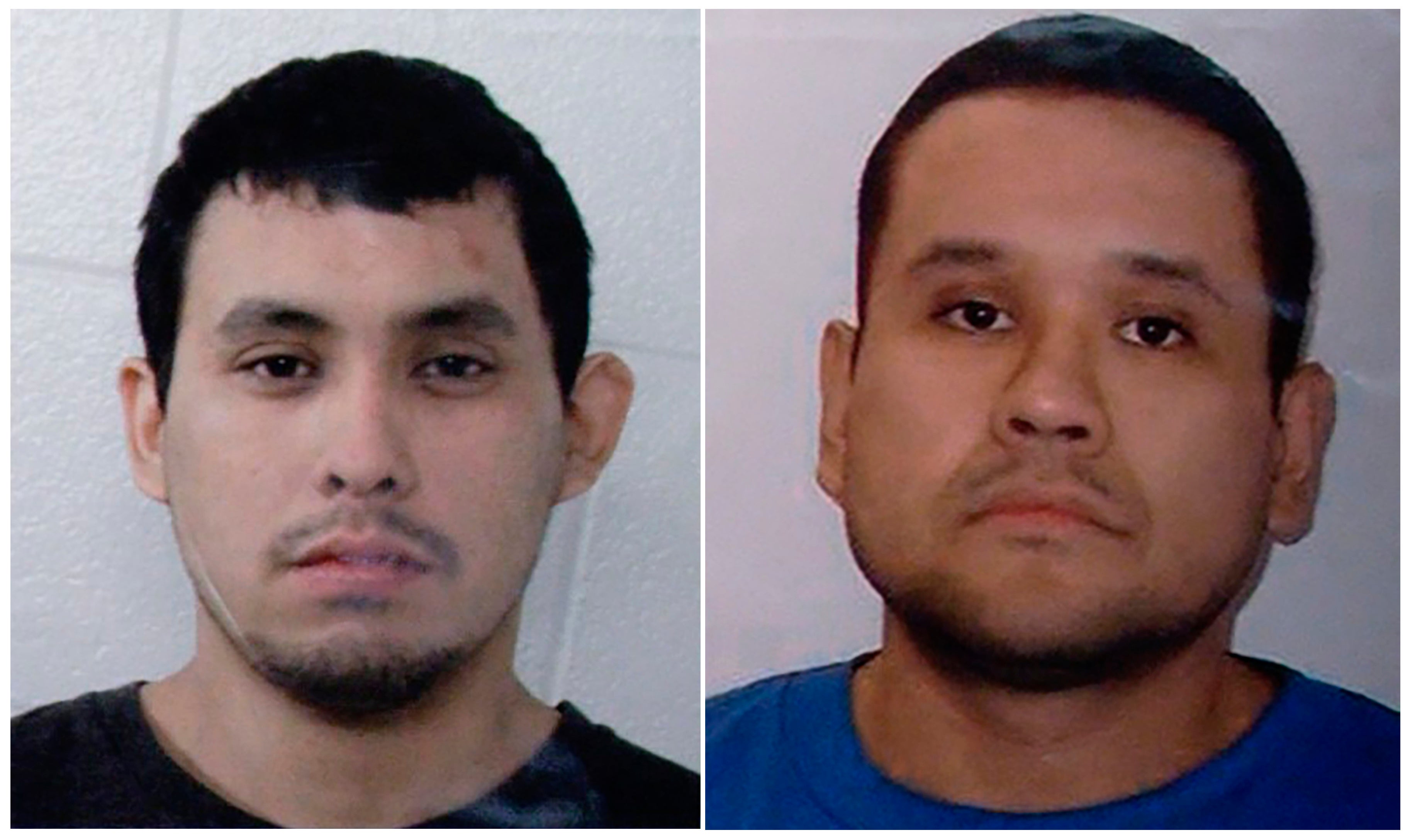
Who are suspects Myles and Damien Sanderson?
A manhunt is currently underway for Myles Sanderson, 32, who is suspected of carrying out the string of stabbings with his brother younger Damien.
Police initially said they were unable to disclose the relationship between the two men, as it was part of their ongoing investigation, but revealed on Monday that they were siblings.
Photographs shared by authorities of the two suspects flared out across social media as the manhunt continued overnight into Monday morning.
At a press conference on Monday, Ms Blackmore gave few details about how Damien Sanderson died, saying only: “His body was located outdoors in a heavily grassed area in proximity to a house that was being examined.
“We can confirm he has visible injuries. These injuries are not believed to be self inflicted at this point.”
Initially, police believed Myles may have fled around 200 miles south towards Regina, the provincial capital. Police described him as a 32-year-old male, 6ft 1in and 240lbs, with brown hair and brown eyes, and believed to be armed and dangerous.
By Tuesday night, authorities had changed gears about where the suspect could be hiding out after receiving a tip that Myles was possibly spotted back at James Smith Cree Nation on Tuesday afternoon.
That tip, however, proved fruitless and by late that night, the Regina Police Department had conceded that they no longer believed the suspect to be in Regina as once thought.
“Early on Sunday we had information that proved to be reliable that Myles Sanderson was in our community and that as a result, the Regina Police Service was assisting the RCMP in trying to locate him,” the chief began in a video address posted to his Twitter. “Today we received information that was leading us to believe he may no longer be in this community.”
Little is known about the motive of the killings. Ms Blackmore said that Myles Sanderson has a criminal record that “dates back years and includes violence”, and he was reportedly listed as “unlawfully at large” by Saskatchewan Crime Stoppers in May.
According to The Globe and Mail, Chief Bobby Cameron of the Federation of Sovereign Indigenous Nations made a statement suggesting that narcotics were part of the mystery.
“This is the destruction we face when harmful illegal drugs invade our communities, and we demand all authorities to take direction from the chiefs and councils and their membership to create safer and healthier communities for our people,” Mr Cameron said.
The remaining suspect may still be driving the stolen black Nissan Rogue SUV, licence plate 119 MPI, that he and his co-suspect allegedly stole over the weekend. However, police said he may now have switched vehicles.
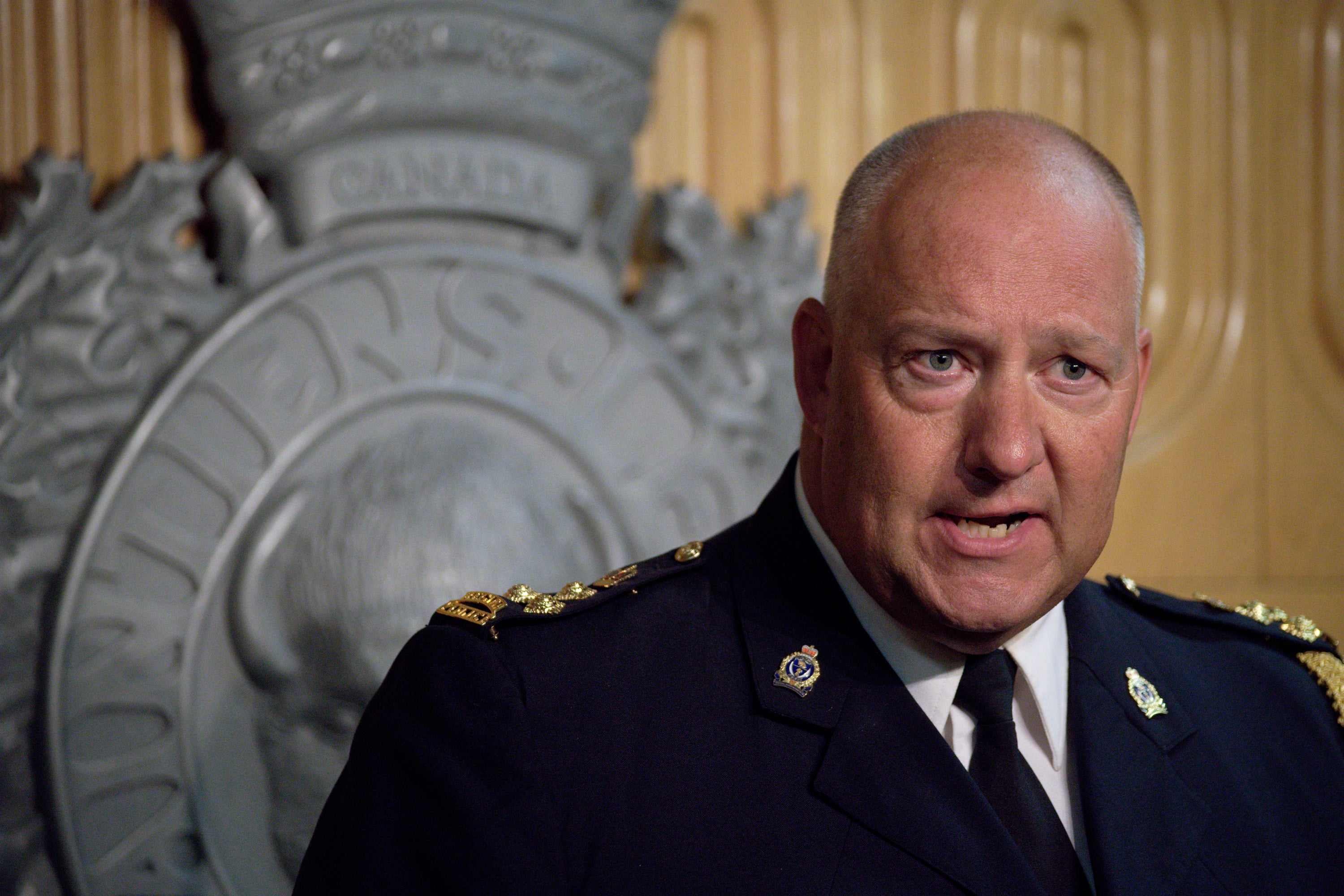
How did the stabbings unfold?
The attacks interrupted a busy holiday weekend in the western province when many had planned family activities or were looking forward to attending the sold-out Canadian Football League game between the Saskatchewan Roughriders and the Winnipeg Blue Bombers
Police responded to the first call of an attack at 5.40am local time on Sunday, when the RCMP Divisional Operational Communications Center (DOCC), received multiple calls about stabbings at multiple locations on the James Smith Cree Nation.
The First Nation, which is located approximately 300km north of the province’s capital, comprises three communities, including the Peter Chapman Band and the Chakastaypasin Band.
Police confirmed later those 13 attacks took place at the First Nation and Weldon, which lies about 25km to the southeast of the first attack.
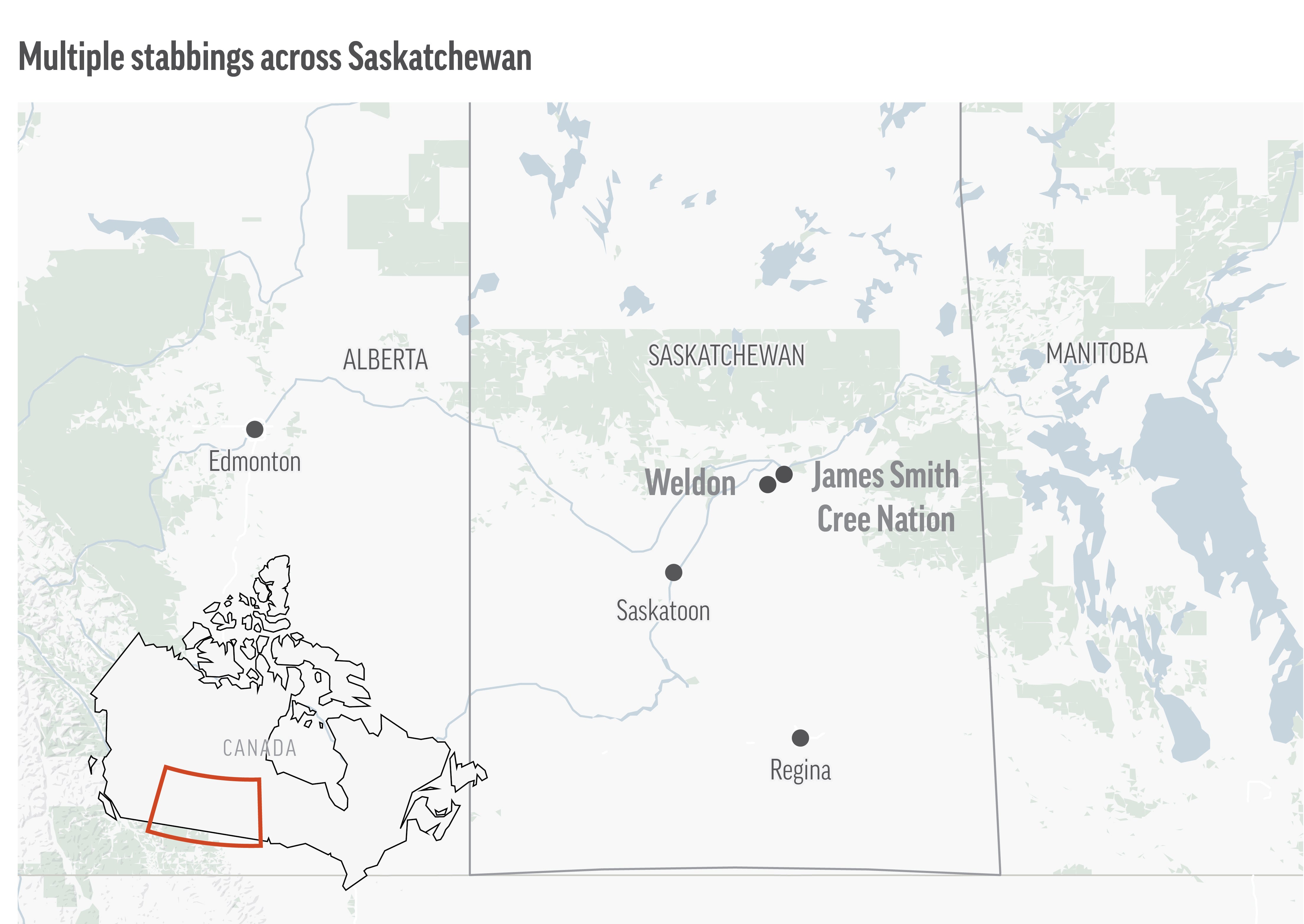
RCMP issued their first dangerous persons alert at 7.12am local time to residents of the James Smith Cree Nation and surrounding communities, alerting them to the fact that there had been multiple stabbings committed by two male suspects. The alert also asked the public to seek immediate shelter and shelter in place.
By 8.20am, the RCMP had extended the dangerous persons alert to the entire province and the identities of the two men, Myles and Damian Sanderson, were released to the public alongside identifying photos with information about the vehicle police believed the pair had used to escape.

By midmorning, officers had extended the dangerous persons alert once more to incorporate the bordering provinces of Alberta and Manitoba, and then a fifth alert was issued at 12.06 alerting residents that the pair had been seen driving on a city street in Regina at around 11.20am.
In response to the attacks, which police described as both targeted and random, the chiefs and councillors of James Smith First Nation declared a state of emergency at around 5pm local time.
“JSCN call this state of emergency to the attention of the Federation of Sovereign Indigenous Nations (FSIN), Prince Albert Grand Council (PAGC), Northern Inter-Tribal Health Authority (NITHA), Athabasca Health Authority (AHA), Canadian Red Cross, Indigenous Services Canada (ISC), Health Canada’s First Nations and Inuit Health Branch (FNIHB), and the Ministry of Health-Province of Saskatchewan,” the statement from the three communities read.
Two Emergency Operations Centres were set up to help provide additional health support to the communities, it added.
Authorities in the province reiterated throughout Sunday that they were dedicated “maximum resources” to locating the wanted men.
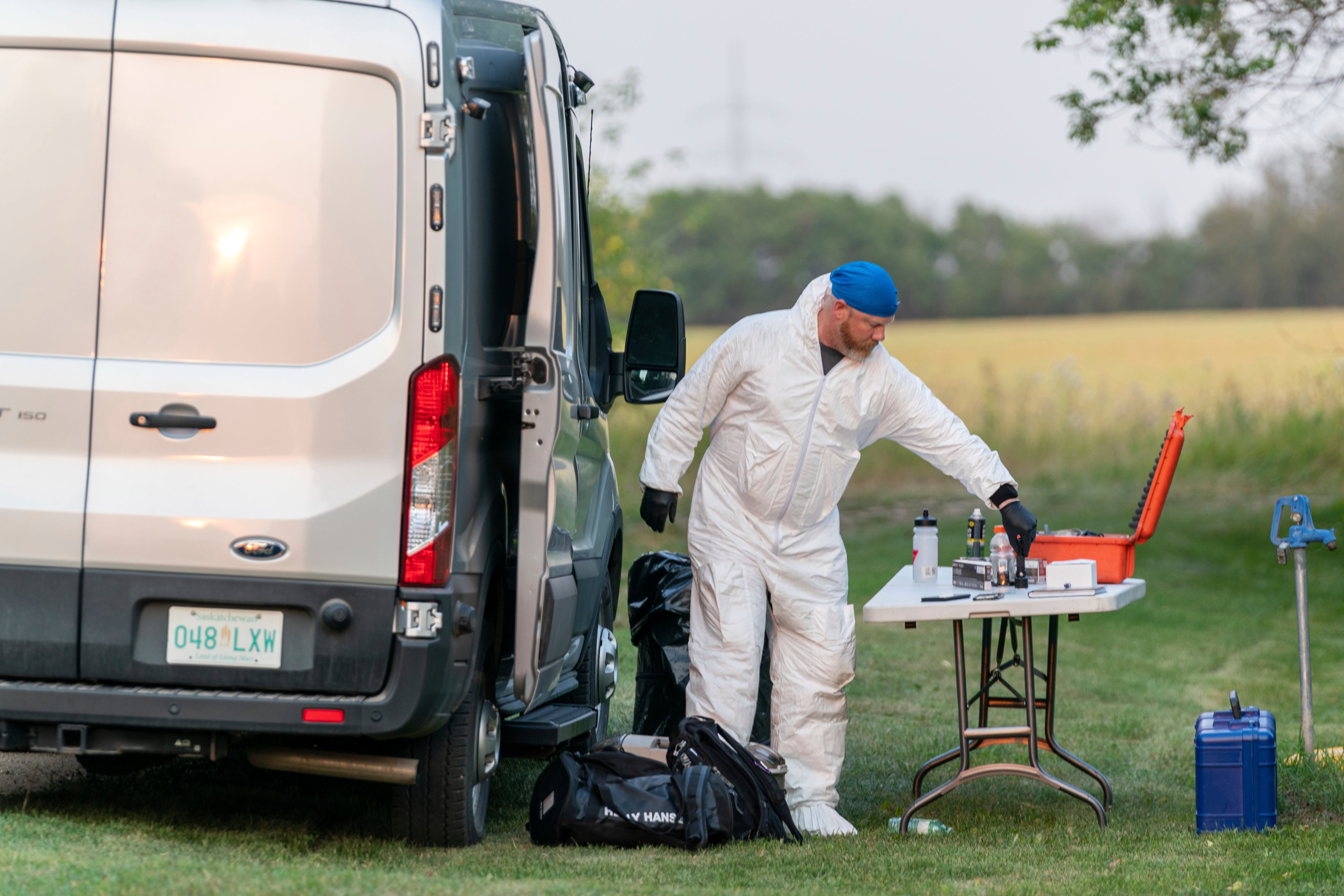
“We are currently actively looking for [them], dedicating maximum resources to this,” said RCMP Assistant Commissioner Blackmore on Sunday afternoon.
Sunday’s Labour Day attack in the prairie province ranks as one of Canada’s deadliest acts of mass violence.
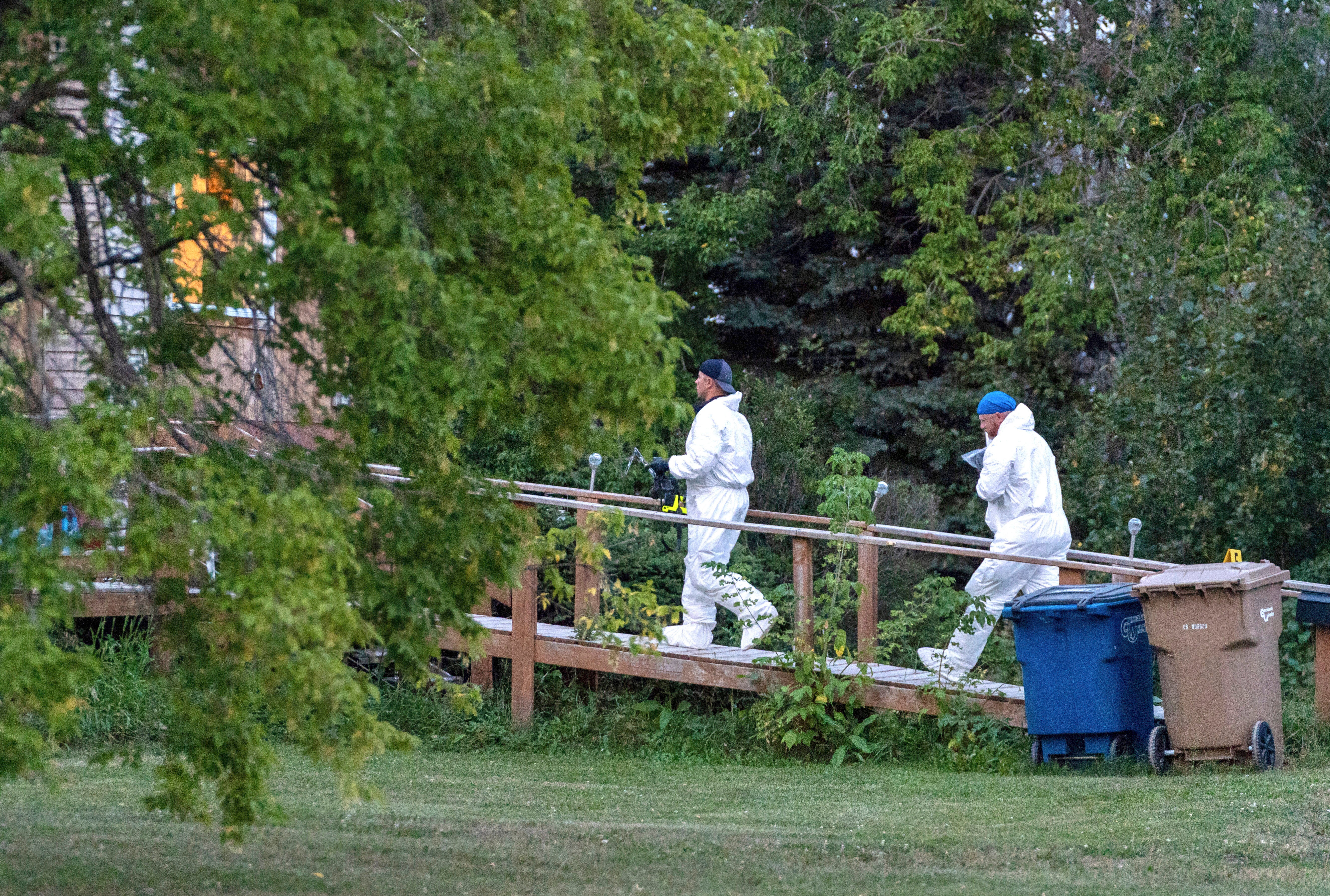
The country’s most deadly gun rampage occurred in 2020, shortly after the country went into lockdown as a result of the then early emerging Covid-19 pandemic. Over the course of 18 hours, a man in the country’s east coast province of Nova Scotia carried out multiple shootings between 18 April and 19 April.
In that attack, Gabriel Wortman, as he was later identified by authorities, killed 22 people and injured three others before he was shot and killed by the RCMP.
Who are the victims?
The victims of the attack have yet to be identified by authorities, but online and in local news reports, friends and family from within the small tight knit communities began to emerge with details about the people who were killed in the brazen attack.
Lana Head, a mother of two, was said to be among the 10 victims killed in the deadly stabbing spree. Head’s former partner, Michael Brett Burns, and the father of their two daughters, said in an interview with Aboriginal Peoples Television Network (APTN) that she and her new partner, who he did not identify, died from their wounds on Sunday.
“I’m hurt for all this loss,” he said, describing how the community continued to mourn and were guarding their privacy in this particularly vulnerable moment.
Residents of village Weldon in Saskatchewan identified 77-year-old Wes Petterson among the victims.
The Associated Press quoted a woman named Ruby Works as saying that Petterson was her uncle.
“He didn’t do anything. He didn’t deserve this. He was a good, kind-hearted man. I’ve known him since I was just a little girl,” said Ms Works. “No one in this town is ever going to sleep again. They’re going to be terrified to open their door.”
Elected officials across the country, both provincial and federal, offered up their condolences to the families and friends of the victims attacked in the seemingly random and unprovoked attack.
“There are no words to adequately describe the pain and loss caused by this senseless violence. All of Saskatchewan grieves with the victims and their families,” wrote Saskatchewan Premier Scott Moe on Twitter on Sunday night.
Prime Minister Justin Trudeau took to Twitter to address the horror that unfolded in the country’s prairie province on Sunday, writing: “The attacks in Saskatchewan today are horrific and heartbreaking. I’m thinking of those who have lost a loved one and of those who were injured.”
“We are closely monitoring the situation, and urge everyone to follow updates from local authorities. Thank you to all the brave first responders for their efforts on the ground.”
A spokesperson for the Saskatchewan Health Authority (SHA), confirmed in an email to CBC Saskatchewan that the health authorities had initiated its emergency response process to respond to the onslaught of casualties in the area, which included tapping into staff from neighbouring regions.
“As with any incident with a high number of casualties, our emergency preparedness teams are responding to the evolving needs to ensure patients are triaged and cared for appropriately,” said spokesperson Anne Lindemann in an emailed statement to the Canadian news outlet.
On Tuesday, the SHA confirmed that 17 people had been admitted to hospital for treatment and only four had been discharged and sent home as of Monday night.
In a statement shared with CBC, the health authority noted that there were still 13 people being treated at various facilities across the province, and that four of those individuals remained in critical care.
Nine of the people in hospital were in stable condition, the SHA said.
The multi-agency-involved manhunt for the pair of wanted men forced law enforcement agencies throughout Saskatchewan to set up checkpoints, with Manitoba and Alberta authorities also being alerted to be on the lookout for the described getaway vehicle.
The Prince Albert Police Service and Regina Police Service were said to be assisting Saskatchewan RCMP in searching for the remaining suspect.
From Prince Albert, Saskatchewan, located about 60km to the west of James Smith Cree Nation, to the capital of Regina, police have set up multiple checkpoints with officers checking for mandatory identification at each crossing.




Join our commenting forum
Join thought-provoking conversations, follow other Independent readers and see their replies
Comments